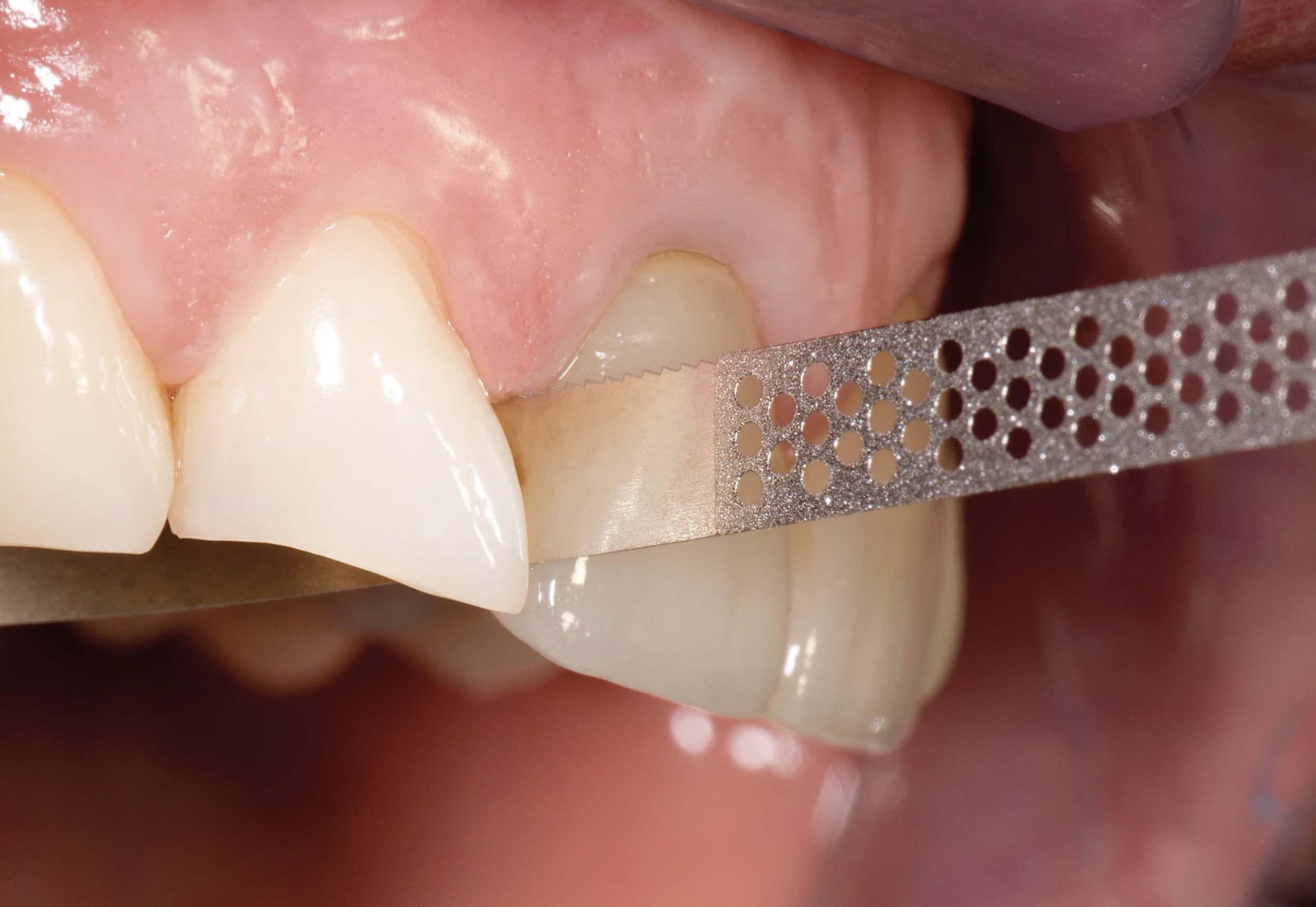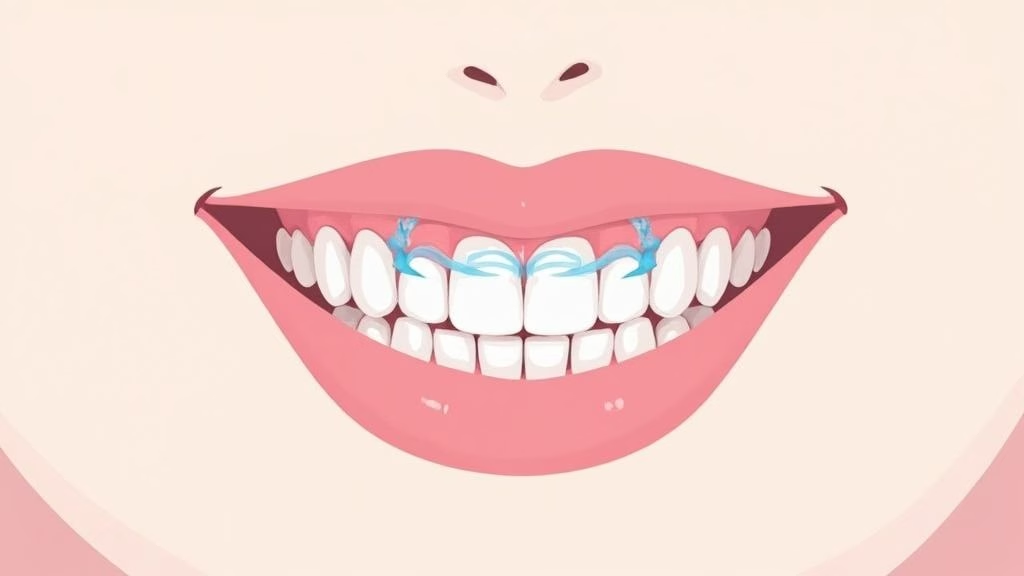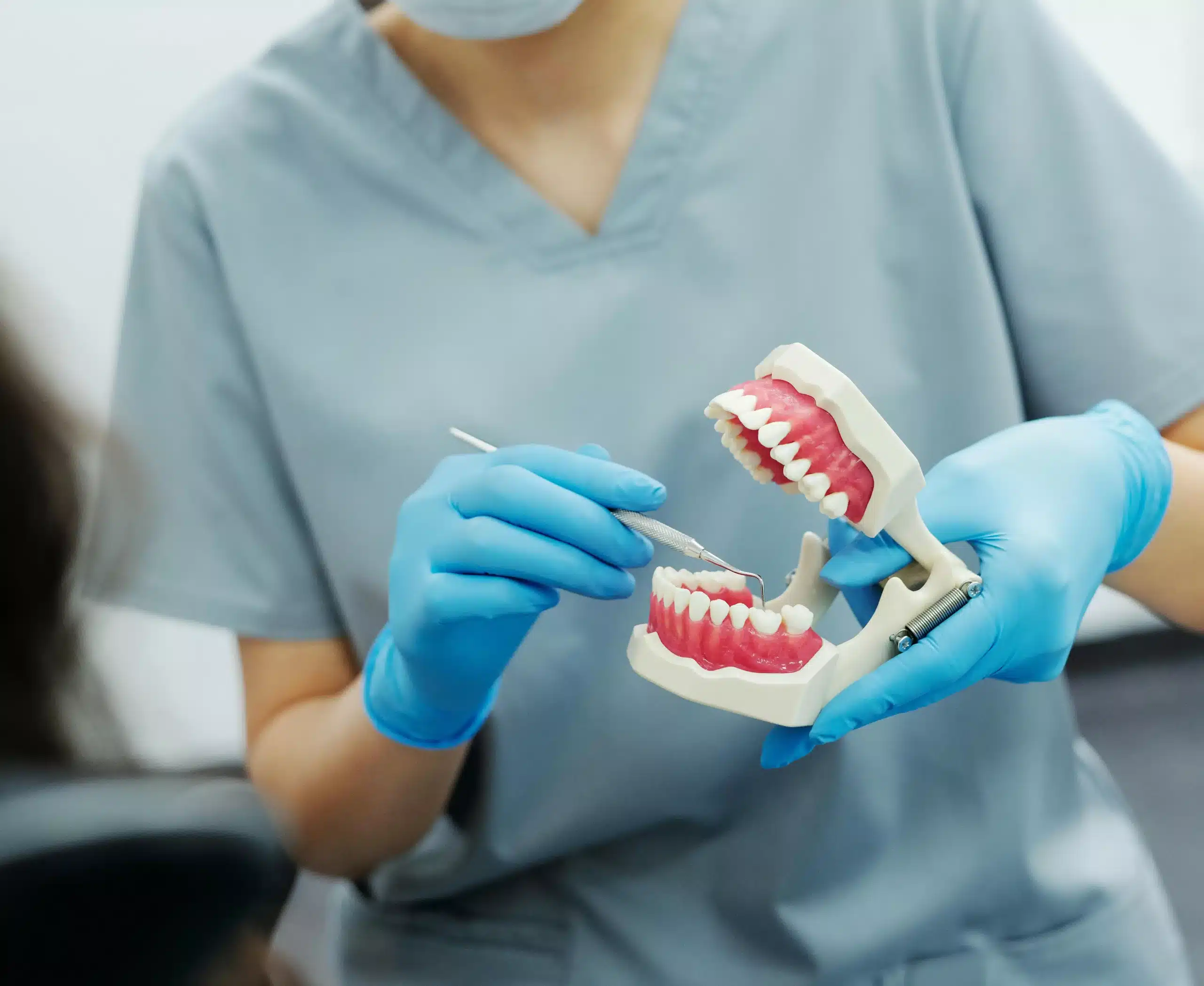How to Close Teeth Gaps: Top Solutions for a Perfect Smile

If you’re looking to close the gaps between your teeth, you’ve got options. From orthodontic treatments like clear aligners to cosmetic fixes like dental bonding, the right choice really depends on the size of the gap and what’s causing it in the first place.
These days, modern solutions from smarter providers like Toothfairy have made it much more convenient and affordable to gently guide teeth into their ideal positions.
Understanding Why You Have Gaps in Your Teeth
Ever wondered why those spaces between your teeth appeared? Clinically, it’s known as a diastema, and figuring out the ‘why’ is always the first step toward finding the best fix for your smile.
For many people, it’s just down to genetics. Sometimes the size of the jawbone doesn’t quite match up with the size of the teeth, leaving natural spaces behind. This is probably one of the most common reasons I see in my practice.
But it’s not always hereditary. Certain habits, especially those from childhood, can play a surprisingly big role.
Common Causes of Teeth Gaps
- Childhood Habits: A persistent thumb-sucking habit can gradually push the front teeth forward, creating a gap over time.
- Tongue Thrust: This is an unconscious habit where the tongue presses against the front teeth when you swallow. Over the years, that gentle but constant pressure can create a space.
- Missing or Undersized Teeth: If a tooth is missing or is naturally smaller than its neighbours (a condition called microdontia), the other teeth can start to drift apart, creating new gaps.
This chart breaks down the most frequent reasons people develop these spaces.
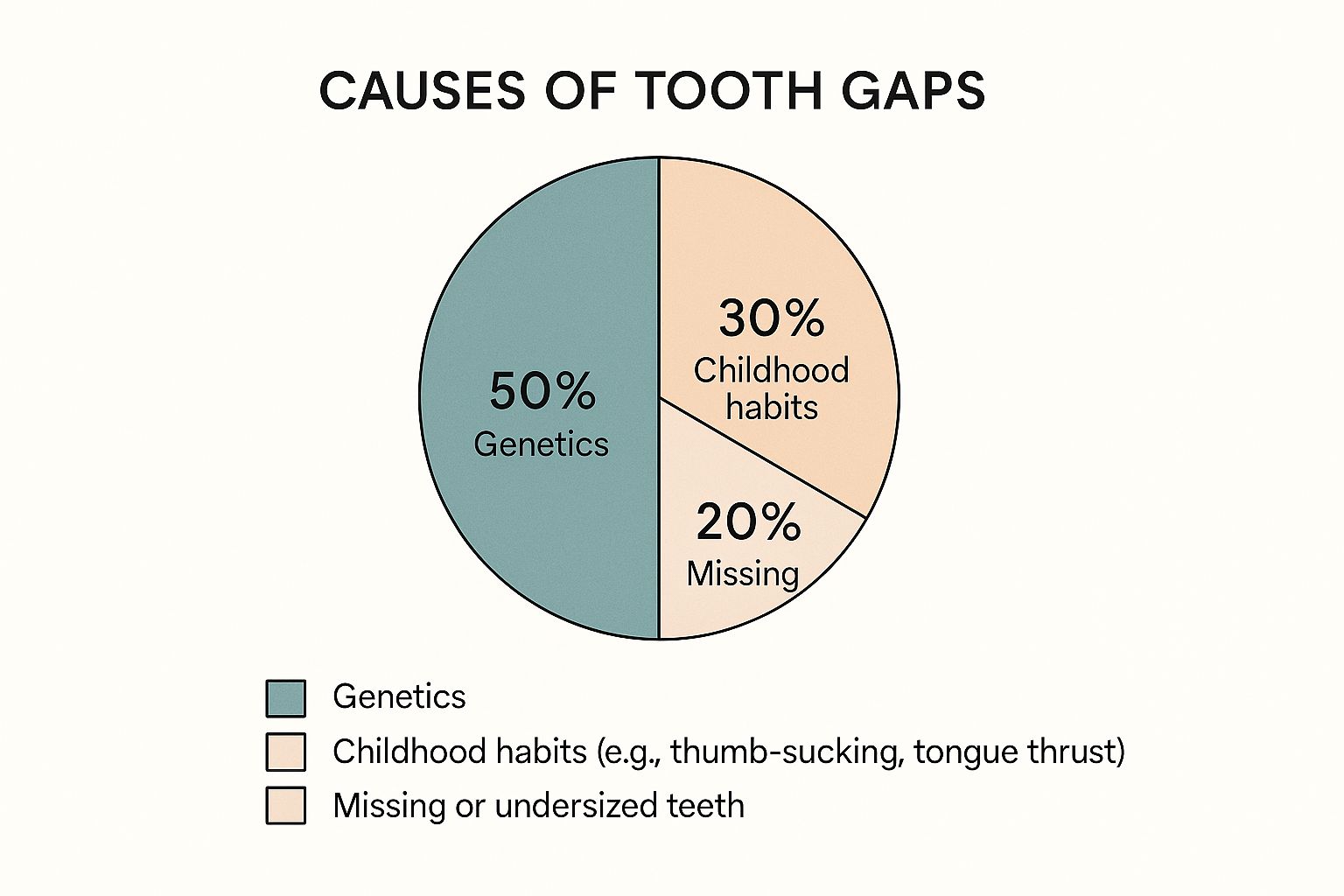
As you can see, while genetics is a major factor, what we do and how we develop also contribute significantly.
It’s important to realise that gaps can be more than just a cosmetic issue. In some cases, they can affect your bite or even make it harder to keep your teeth and gums clean, which can lead to other problems down the line.
This isn’t an uncommon concern here in the UK. In London, for instance, recent data showed that around 28% of adults reported having unmet dental needs, which includes issues like teeth gaps. Many of these individuals found it difficult to even get a dental appointment, highlighting the need for more accessible solutions. You can read more about these dental health trends in the UK.
Finding the Right Way to Close Your Teeth Gaps
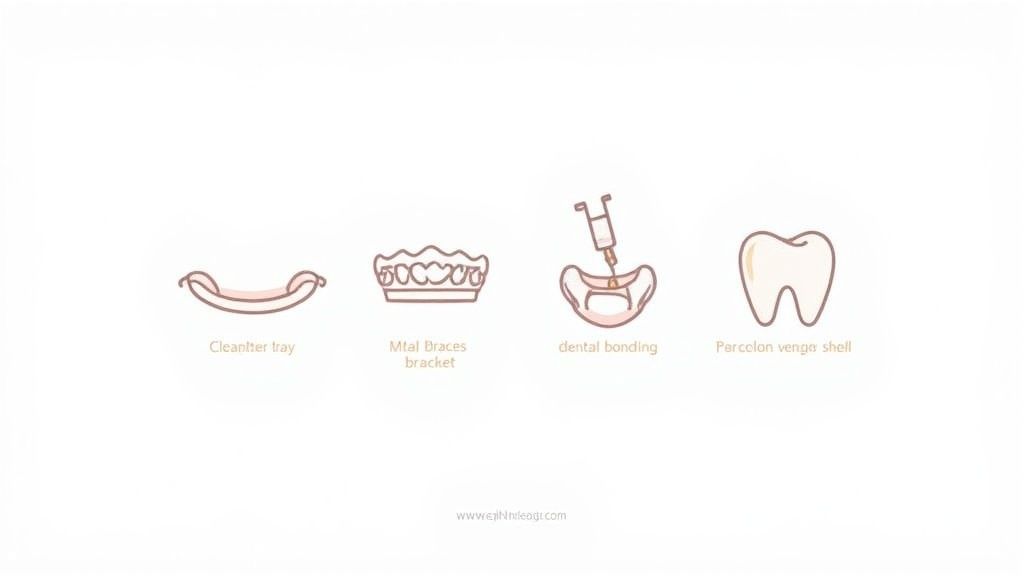
When you decide it’s time to close the gaps in your teeth, you’ll discover there isn’t just one single path forward. The best choice for you really boils down to what you want your smile to look like, what fits your daily life, and of course, your budget.
Each treatment has its own unique set of benefits and drawbacks, from how long it takes to the final cost. Let’s take a closer look at the most common options so you can see how they measure up.
Modern Clear Aligners
Clear aligners have completely changed the game for straightening teeth, offering a discreet way to close gaps without the world knowing. Modern providers like Toothfairy have streamlined the process even further with at-home kits that are managed remotely by certified dentists.
This approach cuts out the need for constant trips to the clinic, making it a more convenient and often more affordable route to a straighter smile. The aligners themselves are custom-moulded to your teeth, applying gentle pressure to gradually shift them into their ideal position. They work brilliantly for many people, but they do require commitment – you’ll need to wear them for 20-22 hours a day to get the best results.
Traditional Metal Braces
For decades, metal braces have been the go-to solution for orthodontic work, and for good reason. They are incredibly effective at closing large gaps and fixing more complicated bite problems that other methods might struggle with. The system of brackets and wires, regularly adjusted by an orthodontist, provides powerful and precise tooth movement.
The main downside for many adults, however, is their appearance. They are very noticeable, and the frequent, time-consuming appointments for adjustments can be hard to fit into a packed schedule. It’s a significant contrast to the flexibility of today’s remote aligner treatments.
Both aligners and braces aim to achieve the same goal—moving your teeth into alignment—but the journey is vastly different. Ultimately, your decision will likely come down to a trade-off between looks, convenience, and how complex your dental situation is.
Quick Cosmetic Fixes: Bonding and Veneers
What if your gaps aren’t from crooked teeth, but just the natural shape or size of your teeth? In that case, cosmetic dentistry offers some fantastic, often much faster, solutions.
- Dental Bonding: Think of this as a quick, artistic fix. A dentist applies a tooth-coloured resin directly onto your tooth, skillfully shapes it to fill the gap, and then hardens it with a special light. The whole thing can be done in one appointment. It’s cost-effective but might not last as long or resist stains as well as porcelain.
- Porcelain Veneers: If you’re looking for a complete smile transformation, veneers are the gold standard. These are ultra-thin, custom-made porcelain shells that fit perfectly over the front of your teeth. They can close gaps, brighten your smile, and hide chips all in one go. The results are stunning and durable, but it’s a bigger financial investment and involves removing a tiny layer of your natural tooth enamel.
Comparing Methods to Close Teeth Gaps
To help you see everything at a glance, here’s a simple breakdown of the main options. This table compares the treatments based on the factors that matter most to patients.
| Treatment | Best For | Average Cost (UK) | Treatment Time | Key Benefit |
|---|---|---|---|---|
| Clear Aligners | Mild to moderate gaps, busy adults seeking discretion | £1,500 – £4,500 | 4-12 months | Nearly invisible and removable |
| Metal Braces | Complex cases, large gaps, and severe bite issues | £2,000 – £5,000 | 12-24 months | Highly effective for all types of issues |
| Dental Bonding | Small, single gaps and minor cosmetic imperfections | £200 – £500 per tooth | 1 dental visit | Fast, affordable, and non-invasive |
| Porcelain Veneers | Multiple gaps, discolouration, or misshapen teeth; a total smile makeover | £500 – £1,200 per tooth | 2-3 dental visits | Dramatic, long-lasting aesthetic results |
Ultimately, the best method is one that aligns with your dental needs and personal preferences. Consulting with a dental professional is always the best first step to creating a plan that’s right for you.
What The Clear Aligner Journey Really Looks Like
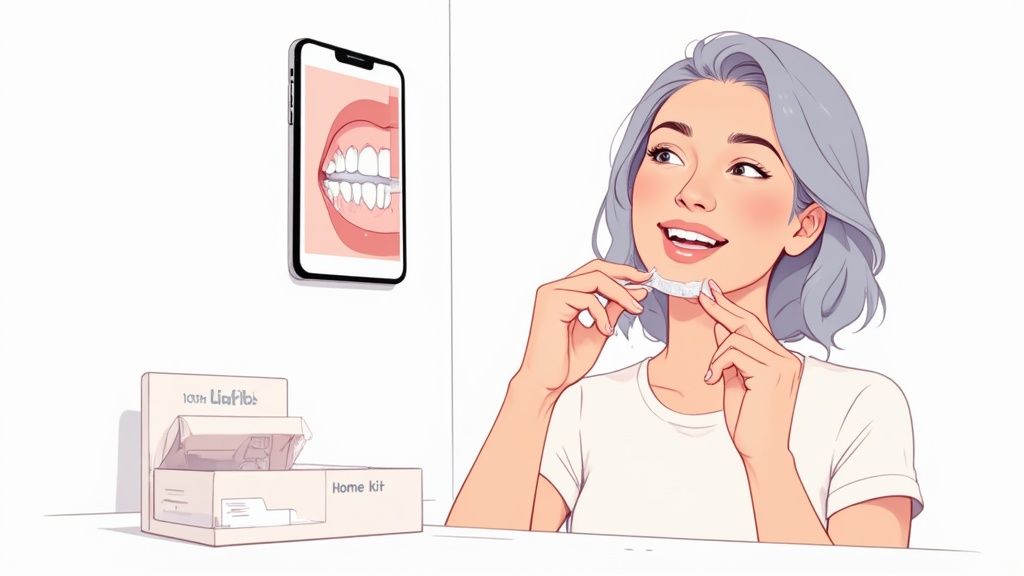
Starting the process of closing your teeth gaps with clear aligners is more straightforward than you might think. Gone are the days of endless dental appointments just to get started. Many modern providers, like Toothfairy, have built the whole system around your convenience, letting you kick things off right from your own home.
It all begins with getting an accurate map of your smile. You’ve got two simple options here: either an easy-to-use impression kit gets posted straight to your door, or you can pop into a partner location for a quick digital scan. This first part is absolutely vital – it’s the blueprint for your entire treatment.
Your Personalised Digital Preview
With your impressions or scan in hand, the dental experts can work their magic. They build a custom 3D model of your teeth, which isn’t just for them – it’s for you. This digital plan gives you a sneak peek into the future, showing exactly how your teeth will shift and what the final result will be before you even commit.
You’ll see a clear visualisation of your teeth moving into place, one small adjustment at a time, until those gaps are gone. This is your opportunity to review everything, ask any questions you have, and make sure you’re happy with the predicted outcome. It puts you firmly in the driver’s seat.
Once you give the thumbs-up, your full set of custom-made aligners is created and shipped directly to you. Each aligner is a tiny bit different from the one before it, engineered to apply a gentle but persistent pressure to guide your teeth.
Each aligner is like a single chapter in your smile’s story. As you swap to a new set every one or two weeks, you’re turning the page, guiding your teeth along a precisely planned path to close the gaps and create a smile you feel great about.
The best part? The entire journey is watched over by qualified dental professionals. Through regular digital check-ins, they keep an eye on your progress, making sure everything is moving as it should. It’s a much smarter and more affordable approach to orthodontics, delivering brilliant results without the hassle of constant clinic visits.
When Bonding or Veneers Are a Better Fit

While clear aligners are fantastic for shifting teeth into a better position, they can’t fix every gap. Sometimes, the space between your teeth has nothing to do with alignment and everything to do with the shape or size of the teeth themselves.
This is where cosmetic treatments really shine.
If you have a condition called microdontia (where some teeth are naturally smaller than they should be), no amount of orthodontic work will make them bigger. The same goes for gaps caused by a chip or general wear and tear. In these cases, you’re looking at a different kind of solution, like dental bonding or porcelain veneers.
Dental Bonding for Instant Results
Think of dental bonding as a bit of dental artistry. It’s a remarkably quick way to close minor gaps, often in a single appointment. Your dentist applies a tooth-coloured resin to the tooth, expertly shapes it to close the gap, and then sets it with a special light.
The trade-off? Bonding material can stain over time and isn’t quite as tough as natural enamel or porcelain. It’s a brilliant solution for a quick fix, but you might find yourself needing a touch-up every few years to keep it looking fresh.
The real beauty of bonding lies in its immediacy. You can walk into the dental clinic with a gap and walk out an hour later with a complete, seamless smile—no waiting required.
Porcelain Veneers for a Total Transformation
If you’re after a more permanent and dramatic change, porcelain veneers are an incredible option. These are ultra-thin, custom-made ceramic shells that are bonded to the front of your teeth.
Veneers are the ultimate multitaskers. They can close gaps, cover up chips, and even hide severe discolouration all at once.
The process usually takes a couple of visits, but the results are built to last. With good care, a set of veneers can give you a flawless, durable smile for well over a decade. It’s a bigger investment, for sure, but the transformation can be absolutely stunning.
Sorting Out the Cost and Finding Treatment in the UK
Let’s talk about the two biggest hurdles when it comes to closing teeth gaps: how much it will cost and where you can actually get it done. The financial side of dental work here in the UK can feel like a maze, particularly when you step into the world of cosmetic treatments.
Your first thought might be the NHS, but cosmetic fixes for small gaps are almost never covered. That means most of us end up looking at private care, where the prices can be all over the place. For example, traditional private braces can set you back anywhere from £2,000 to £5,000, and veneers are often priced per tooth, usually between £500 and £1,200 each.
Why Is It So Hard to Get an Appointment?
The reality is, going private isn’t always a choice. The current crisis in NHS dentistry means that just getting a routine check-up can be a struggle, never mind finding a dentist to help with closing gaps.
As of March 2024, a staggering 21% of general NHS dentist positions were vacant. This has led to massive waiting lists, leaving many people with a tough decision: wait indefinitely or find a private solution. You can read more about how this affects UK dental care.
When you start exploring your options, it’s also worth seeing what cosmetic clinics offer, as many provide a variety of smile-enhancing treatments. Guides for finding local aesthetic clinics can be a really useful place to start your search.
For many people, the traditional private route is just too expensive and time-consuming. It’s this frustration that has paved the way for newer, more accessible methods to get the smile you want without all the old-school hassle.
This is exactly where direct-to-consumer options like Toothfairy come in. By managing everything remotely—from the initial impression kit you do at home to virtual check-ins with dentists—we get rid of a lot of the clinic overheads. It’s an approach that not only brings the price down but also gives you clear, upfront costs and flexible payment plans. You’re finally in the driver’s seat when it comes to investing in your smile.
Still Have Questions About Closing Teeth Gaps? We’ve Got Answers
It’s completely normal to have a few lingering questions, even when you feel ready to take the next step. Let’s tackle some of the most common ones we hear from people just like you.
A big one is always about comfort. “Will it hurt?” is something I get asked all the time. With modern clear aligners, we’re talking about a gentle, gradual pressure. You might notice a bit of tightness for the first day or so after popping in a new set, but that’s actually a good thing! It’s a sign that your teeth are on the move, exactly as planned. It’s a world away from the significant adjustments people remember from old-school metal braces.
How Do I Keep My New Smile Looking Perfect?
This is probably the most important question of all. Once your gaps are gone, you’ll want them to stay gone. The secret? A retainer.
- Why do I need one? Teeth have a sort of ‘memory’ and a natural tendency to drift back to where they started. The retainer’s job is to hold them in their new, corrected position until the surrounding bone and tissues have time to firm up.
- How often will I need to wear it? Your dentist will give you specific instructions, but it usually involves wearing it full-time for a while, before eventually switching to just wearing it at night.
Think of your retainer as the insurance policy on your new smile. Sticking with it is the single best thing you can do to make sure your results last a lifetime.
Finding an orthodontist in the first place can also be a challenge. It’s no secret that the UK is facing a dental workforce shortage, with some estimates suggesting we need at least 3,000 more dentists. This bottleneck often means long waiting lists for orthodontic treatment. You can read more about the challenges in UK dental access. This is precisely why at-home aligner solutions have become such a smart, practical choice for so many people who don’t want to wait.
Ready to finally close those gaps and get a smile you love, without the hassle? See how Toothfairy delivers professional results right from your own home. Start your free online consultation today!
Last updated on October 21, 2025

Toothfairy Care Team
Toothfairy, is the world's smartest dental app, that connects patients to a dentist for a range of issues, from emergencies, cosmetics, prescriptions to virtual exams.
Toothfairy Care Team
Toothfairy, is the world's smartest dental app, that connects patients to a dentist for a range of issues, from emergencies, cosmetics, prescriptions to virtual exams.
